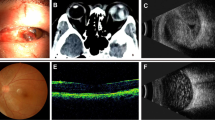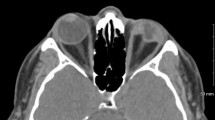Abstract
Purpose
To evaluate the anatomical and functional results of retinal detachment (RD) surgery following closed-globe injuries (CGI).
Methods
Patients treated with vitreoretinal surgeries due to RD following CGI from 2014 to 2020 were retrospectively reviewed. Data included demographics, mechanism of injury, preoperative evaluation, and surgical intervention. Outcome measurements included anatomic success, best corrected visual acuity (BCVA), and possible prognostic factors.
Results
A total of 67 eyes from 64 patients (49 males; mean age 52.84 years) were included. The most common causes of the CGI were work-related injury (22.4%) and traffic accidents (23.9%). The primary and final anatomic success rates were 80.6% (54/67) and 89.6% (60/67), respectively. In the multivariable analysis of the logistic regression models, the poor prognostic factor was proliferative vitreoretinopathy (PVR) (P = 0.009) for primary anatomic success. The median preoperative and final BCVA were logMAR 0.7 (IQR, 0.3–1.6) and logMAR 0.5 (IQR, 0.1–1.1), respectively (P = 0.077). Poorly presenting BCVA (counting fingers or worse) and giant tear were associated with poor visual outcomes.
Conclusion
Work-related injuries and traffic accidents are the prevalent causes of RD following CGI. The anatomic outcomes were favorable, but visual outcomes varied. Poor prognostic factors included PVR and poorly presenting BCVA, highlighting the importance of a careful initial evaluation.

Similar content being viewed by others
Availability of data and material
The datasets used and/or analyzed during the current study are available from the corresponding author on reasonable request.
Code availability
Not applicable.
References
May DR, Kuhn FP, Morris RE, Witherspoon CD, Danis RP, Matthews GP, Mann L (2000) The epidemiology of serious eye injuries from the United States Eye Injury Registry. Graefe's archive for clinical and experimental ophthalmology Albrecht von Graefes Archiv fur klinische und experimentelle. Ophthalmologie 238: 153–157. https://doi.org/10.1007/pl00007884
Nowomiejska K, Choragiewicz T, Borowicz D, Brzozowska A, Moneta-Wielgos J, Maciejewski R, Jünemann AG, Rejdak R (2017) Surgical management of traumatic retinal detachment with primary vitrectomy in adult patients. J Ophthalmol 2017:5084319. https://doi.org/10.1155/2017/5084319
Kuhn F, Morris R, Witherspoon CD, Heimann K, Jeffers JB, Treister G (1996) A standardized classification of ocular trauma. Graefe's archive for clinical and experimental ophthalmology. Ophthalmologie 234: 399–403. https://doi.org/10.1007/bf00190717
Ersanli D, Unal M, Aydin A, Gulecek O, Kalemoglu M (2005) Results of pars plana vitrectomy in closed-globe injuries. Ophthalmic Surg Lasers Imaging Off J Int Soc Imaging Eye 36:182–188
Liu X, Wang L, Wang C, Sun G, Liu S, Fan Y (2013) Mechanism of traumatic retinal detachment in blunt impact: a finite element study. J Biomech 46:1321–1327. https://doi.org/10.1016/j.jbiomech.2013.02.006
Hoogewoud F, Chronopoulos A, Varga Z, Souteyrand G, Thumann G, Schutz JS (2016) Traumatic retinal detachment–the difficulty and importance of correct diagnosis. Surv Ophthalmol 61:156–163. https://doi.org/10.1016/j.survophthal.2015.07.003
Erdurman FC, Sobaci G, Acikel CH, Ceylan MO, Durukan AH, Hurmeric V (2011) Anatomical and functional outcomes in contusion injuries of posterior segment. Eye (Lond) 25:1050–1056. https://doi.org/10.1038/eye.2011.118
Erdurman CF, Ceylan MO, Acikel CH, Durukan HA, Mumcuoglu T (2011) Outcomes of vitreoretinal surgery in patients with closed-globe injury. Eur J Ophthalmol 21:296–302. https://doi.org/10.5301/ejo.2010.5732
Mukkamala LK, Soni N, Zarbin MA, Langer PD, Bhagat N (2017) Posterior segment intraocular foreign bodies: a 10-year review. Ophthalmol Retina 1:272–277. https://doi.org/10.1016/j.oret.2017.01.007
Lee TH, Chen YH, Kuo HK, Chen YJ, Chen CH, Lee JJ, Wu PC (2017) Retinal detachment associated with basketball-related eye trauma. Am J Ophthalmol 180:97–101. https://doi.org/10.1016/j.ajo.2017.05.025
Rouberol F, Denis P, Romanet JP, Chiquet C (2011) Comparative study of 50 early- or late-onset retinal detachments after open or closed globe injury. Retina (Philadelphia, Pa) 31:1143–1149. https://doi.org/10.1097/IAE.0b013e3181f9c22e
Yaşa D, Erdem ZG, Ürdem U, Demir G, Demircan A, Alkın Z (2018) Pediatric traumatic retinal detachment: clinical features, prognostic factors, and surgical outcomes. J Ophthalmol 2018:9186237. https://doi.org/10.1155/2018/9186237
Chen SN, Lian Ie B, Wei YJ (2016) Epidemiology and clinical characteristics of rhegmatogenous retinal detachment in Taiwan. Br J Ophthalmol 100:1216–1220. https://doi.org/10.1136/bjophthalmol-2015-307481
Chang YS, Teng YT, Huang YH, Liu ML, Hung JH, Hsu SM, Huang FC, Shih MH, Chen WJ, Lai CC, Hsiao SF, Wang SH, Tseng SH (2018) Major ocular trauma in Taiwan: 2002–2004 versus 2012–2014. Sci Rep 8:7081. https://doi.org/10.1038/s41598-018-25030-6
Goffstein R, Burton TC (1982) Differentiating traumatic from nontraumatic retinal detachment. Ophthalmology 89:361–368. https://doi.org/10.1016/s0161-6420(82)34783-1
Orban M, Islam YF, Haddock LJ (2016) Timing and outcomes of vitreoretinal surgery after traumatic retinal detachment. J Ophthalmol 2016:4978973. https://doi.org/10.1155/2016/4978973
Ehrlich R, Polkinghorne P (2011) Small-gauge vitrectomy in traumatic retinal detachment. Clin Exp Ophthalmol 39:429–433. https://doi.org/10.1111/j.1442-9071.2011.02485.x
Chronopoulos A, Hattenbach LO, Schutz JS (2021) Pneumatic retinopexy: a critical reappraisal. Surv Ophthalmol 66:585–593. https://doi.org/10.1016/j.survophthal.2020.12.007
Williamson TH, Lee EJ, Shunmugam M (2014) Characteristics of rhegmatogenous retinal detachment and their relationship to success rates of surgery. Retina (Philadelphia, Pa) 34:1421–1427. https://doi.org/10.1097/iae.0000000000000094
Murtagh PJ, Stephenson KA, Rhatigan M, McElnea EM, Connell PP, Keegan DJ (2020) Rhegmatogenous retinal detachments: primary reattachment rates and visual outcomes over a 4-year period. Ir J Med Sci 189:355–363. https://doi.org/10.1007/s11845-019-02084-7
Oderinlo O, Hassan A, Okonkwo O, Bogunjoko T, Idris O (2020) Are outcomes of surgery for retina detachments from giant tears worse than from other holes and tears in this era of small gauge vitrectomy and perflorocarbon use in Sub-Saharan Africa? Niger J Clin Pract 23:1248–1253. https://doi.org/10.4103/njcp.njcp_227_20
Acknowledgements
The authors thank the Biostatistics Task Force of Taichung Veterans General Hospital for their support with the statistical analysis.
Funding
The authors did not receive support from any organization for the submitted work and have no relevant financial or non-financial interests to disclose.
Author information
Authors and Affiliations
Contributions
All authors contributed to the study conception and design. Chung-Hao Hsiao, Hung-Ju Chen, and Wei Ping Hsia participated in the data collection. The first draft of the manuscript was written by Chung-Hao Hsiao and all authors commented on previous versions of the manuscript. All authors were involved in the interpretation of the results and discussion of the clinical significance. All authors read and approved the final manuscript.
Corresponding author
Ethics declarations
Conflict of interest
The authors declare that they have no conflicts of interest/competing interests.
Ethical approval
Approval was obtained from the ethical research committee of Taichung Veterans General Hospital. The procedures used in this study adhere to the tenets of the Declaration of Helsinki.
Consent to participate
Not applicable.
Consent for publication
Not applicable.
Additional information
Publisher's Note
Springer Nature remains neutral with regard to jurisdictional claims in published maps and institutional affiliations.
Rights and permissions
About this article
Cite this article
Hsiao, CH., Chen, HJ., Hsia, W.P. et al. Surgical outcomes and prognostic factors in traumatic retinal detachment following closed-globe injuries. Int Ophthalmol 42, 1849–1860 (2022). https://doi.org/10.1007/s10792-021-02182-5
Received:
Accepted:
Published:
Issue Date:
DOI: https://doi.org/10.1007/s10792-021-02182-5




